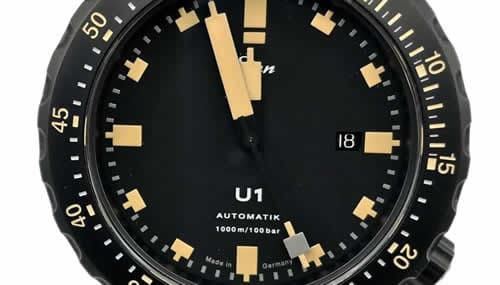
Watches, like cars, are differentiated by price. Luxury brands like Porsche, Mercedes, or BMW don’t typically offer what most of us consider to be “affordable” cars, and one look at the sticker on a Bentley or Lamborghini will let you know that prices can rise to astronomical figures.
That’s just as true in horology. Brands like Rolex, Omega, and Tudor command high prices, to be sure, but nothing in the range of Patek Phillipe, Audemars Piguet, or Vacheron Constantin.
And with all the attention that’s rightly paid to these luxury watchmakers, you can feel left out in the cold if you don’t have at least four figures to spend on a watch.
But that needn’t be the case.
One of my favorite segments is the under-$500 segment, as there are truly wonderful, absolutely affordable watches to be found – even with complications like the chronograph.
What is a “chronograph?”
In its simplest terms, a chronograph is a watch with a stopwatch function. In practice, this means that you time the duration of events like a Sunday roast or a 50-yard sprint.
And if the bezel or dial is marked for a tachometer, you can use your watch to determine speed over a known distance, a useful feature in very specific situations.
Most people don’t really use their chronometers as stopwatches, though. Instead, they’re popular for their technical, sports-inspired look.
Let’s explore some of my favorite chronographs under $500.
Tissot PRC 200 43mm Ref.T114.417.11.057.00

Tissot is one of the few high-end Swiss watchmakers that doesn’t ignore the entry-level segment, and if you know where to look, it offers stunning deals for far less than you’d imagine.
Consider the PRC 200 43mm. The polished case and bezel frame a black dial marked with a tachymeter ring at the margin. Three sub-dials allow for precise time keeping via pushers above and below the crown.
The tachymeter is easily legible at an angle, a nod to real-world utility rather than simple fashion, and if you’re looking for a watch that really can be used as intended, this Tissot is a very good place to start.
And there’s style here, too, not just craftsmanship and careful design: the yellow second hand, fashioned into a “T,” as well as two yellow sub-dial hands add a pop of color that plays very well indeed with the dark dial.
This is a watch that will earn compliments on your wrist, and in terms of pure aesthetics, its winning combination of dial design, bracelet execution, and Tissolt quality allow it to punch well above its weight class in terms of price.
Tissot equips the PRC 200 with the ETA G10.212, a well-respected quartz movement that delivers excellent accuracy (within 10 seconds a month).
Battery life is excellent, and when power gets low, the PRC 200 will begin to tick away in four-second increments, letting you know it’s time to drop in to your local boutique.
This simple, reliable movement choice is a nod toward affordability that helps Tissot keep entry-level pricing from rising to eye-watering heights. Expect to pay $572 at full retail for the PRC 200.
Timex Marlin

Timex leans into mid-century racing with the sporty Marlin Chronograph Tachymeter. For enthusiasts who can’t get enough of vintage style, it’s an outstanding option with a funky, retro vibe that shares aesthetic cues with the TAG Heuer Carrera.
In keeping with the standards set by vintage watches, Timex has chosen a domed acrylic crystal. That can decrease legibility at the edges – all domed acrylic crystals share this flaw – but in this case, it’s truly a feature and not a bug.
For connoisseurs of the adrenaline-fueled speed obsession of the 1960s, it’s the look rather than the usability of the chronometer function that drives the appeal of this Marlin.
A flat crystal would break the illusion this watch seeks to create, and the play of light across that acrylic pairs beautifully with the “panda-style” dial design.
And while this watch is eminently affordable, it has good looks and charm that allow it to pass in the world of luxury, no-one the wiser.
A silver-tone dial with beautiful brushwork provides the backdrop for the chronometer’s three sub-dials. 60s-inspired hour markers at the 3, 9, and 12 complement this look, as does the date window between the 4 and 5.
Timex employs the Seiko VK64 meca-quartz hybrid movement in the Marlin Chronograph Tachymeter, and excellent accuracy, mechanical-style sweeping seconds, and hassle-free battery changes are what you can expect.
Expect to pay just $239 for this watch, making it an exceptional bargain if you love its romantic, retro styling.
Yema Rallygraf Meca-Quartz II Reverse Panda Ref. YMHF1580-AA

Yema demonstrates time and time again that French horology is anything but content to rest on its laurels. And you can see in their Rallygraf Meca-Quartz II “Reverse Panda” how Yema looks to the future by referencing the past.
Many chronometers are styled to re-capture the excitement of mid-century racing. We’ve already seen that with the Marlin, and here, Yema thales that irresistible 60s vibe one step further.
A polished case houses a matte-black dial with cream margins and subdials that capture the racing watches that made rally racing possible. A super-legible tachymeter scale is printed on the black bezel, keeping the dial clean and clear.
Fat, luminous baton hands and hour markers make at-a-glance legibility excellent, and tasteful brand markings, script “Rallygraf,” dual checkered flags, and “France” grace the dial without leading to busyness.
As you’d expect for a racing watch, Yema supplies a rally-ready leather strap that looks as fast as a ‘67 Mini Cooper S.
Like the Timex, Yema has chosen the Seiko VK64 meca-quartz movement for the Rallygraf, making this watch as accurate as it is easy to service and maintain. Again, that’s a price-conscious move that puts this beautiful Yema within striking distance of most budgets.
Expect to pay just $369 for the Rallygraf Reverse Panda – it’s worth every penny.
Citizen Eco-Drive Brycen Chronograph Ref. CA0649-14E

Citizen isn’t just committed to satisfying price-conscious watch enthusiasts. Their innovative Eco-Drive, using light to power your watch with no battery changes, no winding, and no hassle is truly cutting-edge, and when combined with sharp design, results in a fantastic daily wearer.
This Brycen Chronograph is offered with a matte-black dial, a retro-style tachymeter bezel, and sub-dials that pop with orange highlights.
At 44mm, this watch may be a bit too large if you have smaller wrists, and it’s definitely eye-catching, drawing on the same racing-inspired aesthetics as many of the chronographs on my list today.
That said, it’s a bit more modern than Yema or Marlin to my eye, splitting the difference between mid-century cool and modern.
Citizen powers this watch with its Eco-Drive, specifically the Citizen Caliber B612. Charged by dial exposure to light – natural or artificial – it stores up to seven months of electricity, and in practice, running low isn’t realistic. It also provides exacting quartz accuracy, keeping time to within 15 seconds a month.
For hassle-free wear, daily time-telling, and more than a touch of swagger, the Citizen Brycen Chronograph simply can’t be beat for just $340.
Dan Henry 1962 “Evil Panda”

Dan Henry’s watchmaking has been exciting enthusiasts for some time, and the brand’s love of updated-but-retro design is universally beloved. And among the most striking of Dan Henry’s collection is the 1962 “Evil Panda.”
A polished steel case frames a matte-black dial and modern tachymeter bezel. The dial is admirably clean: just a simple logo at the top, three white sub-dials, simple hour and minute hands, and a crimson second hand that adds a touch of daring pop.
Easily among the best-looking chronographs in this price range, if you’re not already familiar with Dan Henry, you should be! And for people with smaller wrists, the Evil Panda’s 39mm case is a perfect fit.
They team with Seiko to offer the VK63 meca-quartz movement in this watch, a time-tested power-plant that keeps time very well indeed while demanding only infrequent battery changes from you.
Expect solid quartz-grade accuracy, as well as remarkable shock resistance when compared with similarly priced automatics.
If real-world performance matters to you, specifically, accuracy, vibration tolerance, and instant legibility, the Evil Panda should get a second – and perhaps a third – look.
It’s rare at the entry level for a clean, clear dial to look so good, and the overall aesthetics of this watch threaten to unseat much more expensive competitors.
This timepiece retails for $280.
Vaer RS1 Rally Chronograph

It should come as no surprise that I’m a huge fan of Vaer watches, especially the RS1 Rally Chronograph. Vaer really leans into entry-level quality without skimping on visually-striking design.
Vaer’s case finishing matches perfectly with the RS1’s cream dial and TV-style sub-dials. ANd the added colors not only add visual interest, they improve legibility by creating eye-catching contrasts that are as practical as they are attractive.
Vaer has added a screw-down crown to the mix, as well bright luminous markings to the hands and dial, making the RS1 just about as easy to read at a glance as the Dan Henry Evil Panda.
And like many competitors in this segment, Vaer relies on the Seiko VK63 meca-quartz movement. As you’d expect, it functions very well indeed for a watch designed for the rigors of daily wear.
I probably wouldn’t wear a $5,000 chronograph to work and play without constantly worrying about what might happen to it. With the RS1 on my wrist, I’d never give my watch a second thought, except when someone compliments it!
The Vaer RS1 Rally Chronograph can be yours for $339.
Brew Retrograph Technicolor

The world runs on caffeine, and Brew is more than superficially connected to coffee. Their Retrograph Technicolor, inspired by the design hallmarks of espresso machines, brings function and form into well-balanced harmony.
Measuring 38 by 41.5 mm, its rectangular case contains a medium-blue dial with rounded square subdials and blue, yellow, and red highlights. Not only do these highlights improve at-a-glance legibility, they also allow you to time your espresso perfectly.
How?
You’ll notice that the hour markers are set off with red and blue pips, while the seconds from 30 to 35 are marked in yellow.
That 30- to 35-second time span is ideal for extracting espresso from grounds with pressurized steam, helping you get the perfect dark, rich brew each morning.
A small touch, perhaps, but a real nod toward modern practicality, too.
The overall look of the Retrograph Technicolor is decidedly 70s, and it’s easy to appreciate its bold aesthetics and clean styling.
And – you guessed it – the Seiko VK63 is the beating heart of this chronograph, promising trouble-free reliability and little to no service necessary beyond battery changes.
Also available with a steel bracelet, the standard model retails for $375.
Conclusion
As you can see, the below $500 segment of chronograph watches couldn’t be richer with style, panache, and racing-inspired adrenaline. And it’s just as clear that while you can spend a lot more, you can also find a beautiful watch for far less than you might expect.
So while it’s certainly true that luxury watches can command top dollar, inexpensive watches are increasingly competitive, especially if you know where to look.

















































